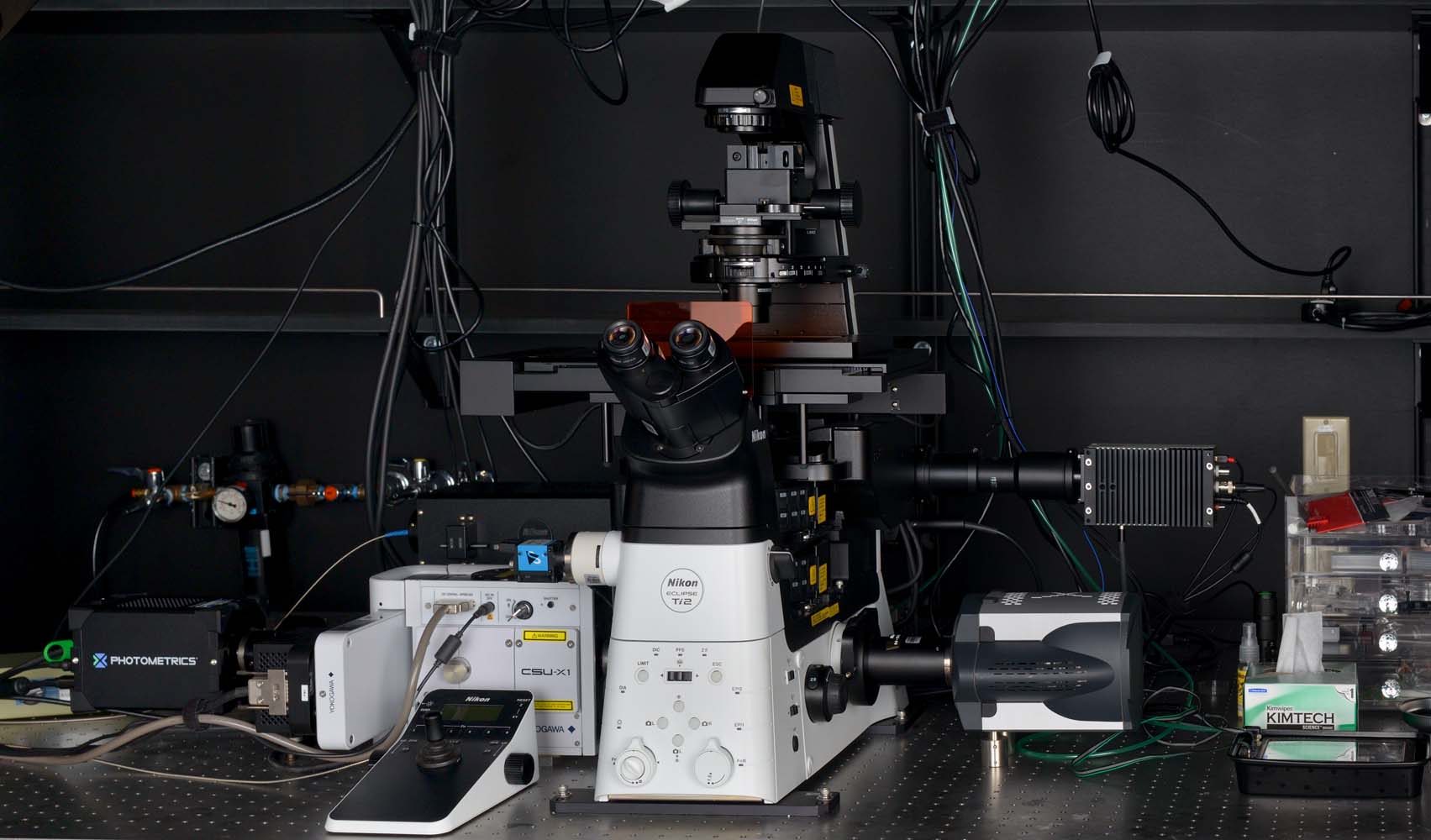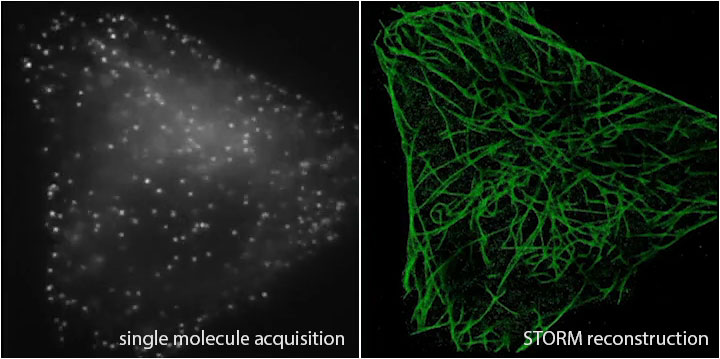Sterling: X1 Spinning Disk, TIRF, STORM microscope

Summary
Sterling is a multifunctional microscope and is equipped for 5 image modalities: spinning disk confocal imaging, Total Internal Reflection Fluorescence (TIRF) imaging, Stochastic Optical Reconstruction Microscopy (STORM), photo activation and stimulation, and bright field. Live cells that express fluorescent proteins at low levels are easily imaged using the spinning disk confocal mode due to the mild illumination method and a sensitive camera. Complete automation in combination with perfect focus system make this an ideal system to acquire live cell pro-longed time-lapses (< 72 h). Biological processes which occur at or near the membrane are best studied using the TIRF mode. In addition, single molecule studies (e.g. tracking or photo physics) are performed using the TIRF mode due to the high-power lasers. Furthermore, super-resolution images are obtained using the STORM modality. This system is fully equipped with stage top incubator for live cells, nonetheless, this system is also suited for fixed cells and non-biological samples.
Image modalities
- Spinning disk confocal imaging
- TIRF (also HILO / ‘dirty’ TIRF)
- (3D) STORM
- Photo activation/stimulation
- Brightfield
Applications
Spinning disk confocal imaging
- Immunofluorescence. Images are acquired fast compared to a laser scanning confocal and the Piezo Z drive allows fast Z stacking.
- (Fast) live cell imaging. Spinning disk illumination is very mild for your sample, which is beneficial when imaging fluorescent proteins. The stage top incubation chamber regulates the temperature (30 – 40 ⁰C), CO2 and humidity.
- Pro-longed time-lapse live cell imaging. The perfect focus system controls the focus very precisely and can be used over a long-time course (< 72 h).
- Filter FRET / ratiometric FRET. Filter FRET using blue, green, red and far red fluorescent dyes or fluorescent proteins can be performed.
TIRF modality
- Membrane processes in live cells. Processes that occur 200 µm from the cover slip can be very well studied with TIRF.
- Single molecule tracking in live cells. This can be done near the membrane in full TIRF or relatively higher using HILO TIRF.
- Single molecule photo physics. Non-biological samples are also compatible on this microscope.
STORM modality
- STORM and 3D STORM. These super resolution techniques can be performed on live and fixed biological samples. Our analysis workstations are also equipped with the full N-STORM analysis package.
Technical description
|
|
Specifications |
|
|
Microscope body |
Eclipse Ti2-E |
|
|
Stage |
Automated |
|
|
Piezo drive |
Mad City Lab Inc. 200µm |
|
|
Perfect Focus system (PFS) |
Yes |
|
|
Incubator |
Tokai Hit stage top incubator, and full enclosure (30 – 40 ⁰C), CO2 and humidity (including objective heater and temperature sensor) |
|
|
Objectives |
Correction, Magnification, Numerical Aperture, Working Distance |
|
|
Plan Apo ʎ 10x NA 0.45 air Plan Apo ʎ 20x NA 0.75 air WD 1000µm S Fluor 40x NA 1.30 oil Plan Apo ʎ 60x NA 1.40 oil WD 130µm Apo TIRF 60x NA 1.49 SR HP APO TIRF 100x NA 1.49 WD 120µm |
||
|
Software |
NIS-Elements software (version 5.21.03 High content analysis package) |
|
|
Lasers |
405nm, 488nm, 561nm, 640nm (Agilent laser box) |
|
|
Yokogawa spinning disk |
CSU-X1-50 µm pinholes |
|
|
Emission filters |
Quad dichroic (DAPI/FITC/TRITC/CY5-for laser lines 405nm, 477nm, 546nm and 638nm) 432/36nm, 515/30nm, 595/30nm, 755/189nm DAPI 455/50nm GFP 525/36nm TRITC 600/50nm Cy5 705/72 nm |
|
|
Detector |
Prime 95B sCMOS camera (Photometrics) 95% Quantum Efficiency 11 µm x 11 µm Pixel Area 80fps 18.8 mm FOV |
|
|
DIC/Brightfield |
Diascopic LED |
|
|
TIRF |
|
Specification |
|
Lasers |
405nm, 488nm, 561nm, 640nm (Agilent laser box) |
|
|
Angle control |
N-STORM illumination |
|
|
Emission Filter |
450/56nm, 525/47nm, 603/44nm, 730/56nm |
|
|
Detector |
iXon Ultra 897 EMCCD camera (Andor) |
|
|
Objective |
Apo TIRF 60x NA 1.49 SR HP APO TIRF 100x NA 1.49 WD 120µm |
|
|
STORM |
|
Specification |
|
Lasers |
561nm, 640nm |
|
|
Magnification lenses |
1x, 2x, 4x or 8x (astigmatic lense) |
|
|
Objective |
SR HP APO TIRF 100x 1.49 NA WD 120µm |
|
|
Photo activation and stimulation |
SDCM/TIRF compatible (digital mirror device by Polygon) Light source: AuraII (Lumencor) 395/25nm, 470/24nm, 555/28nm, and 640/30nm |
|
Location
Leichtag building, Room 470
